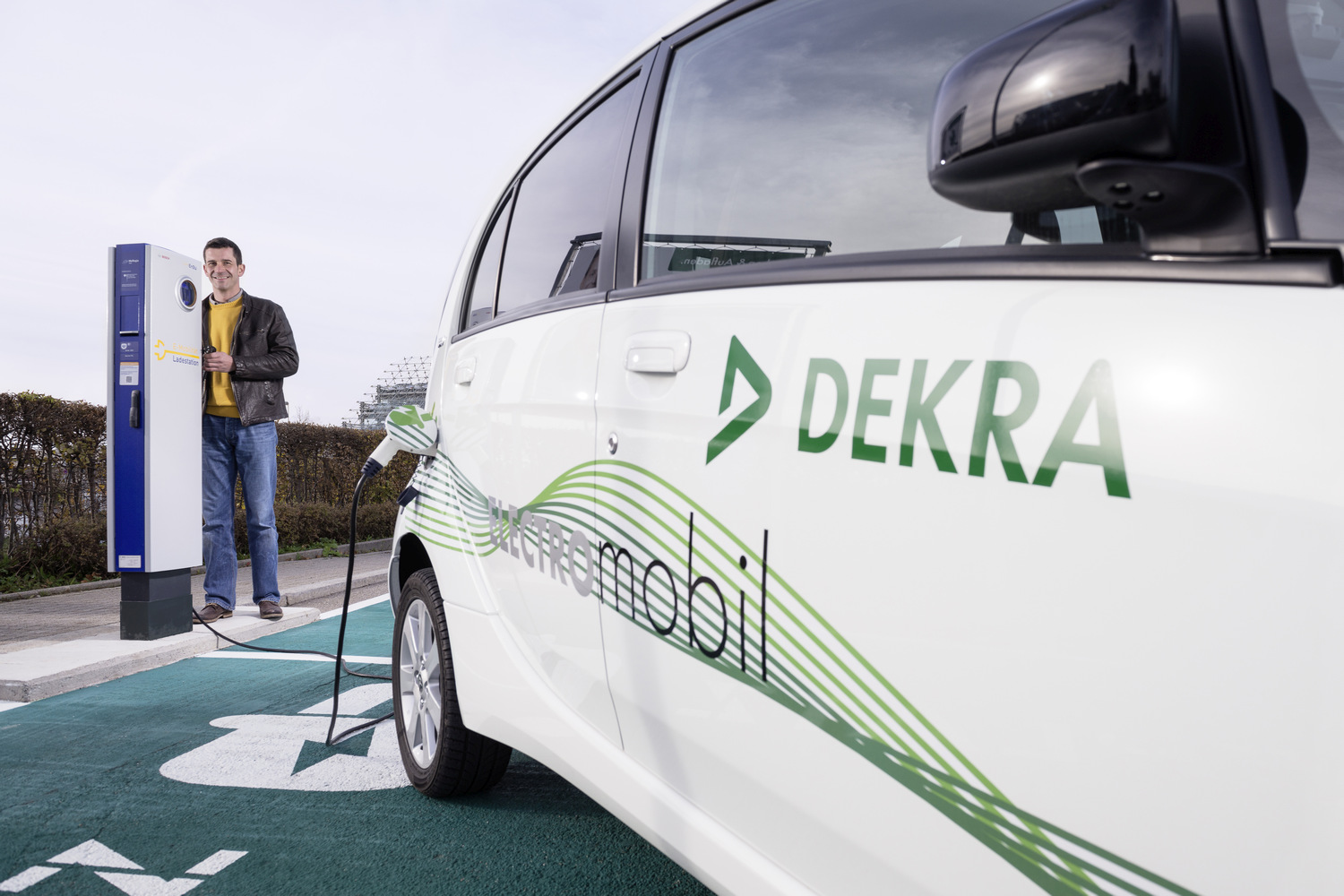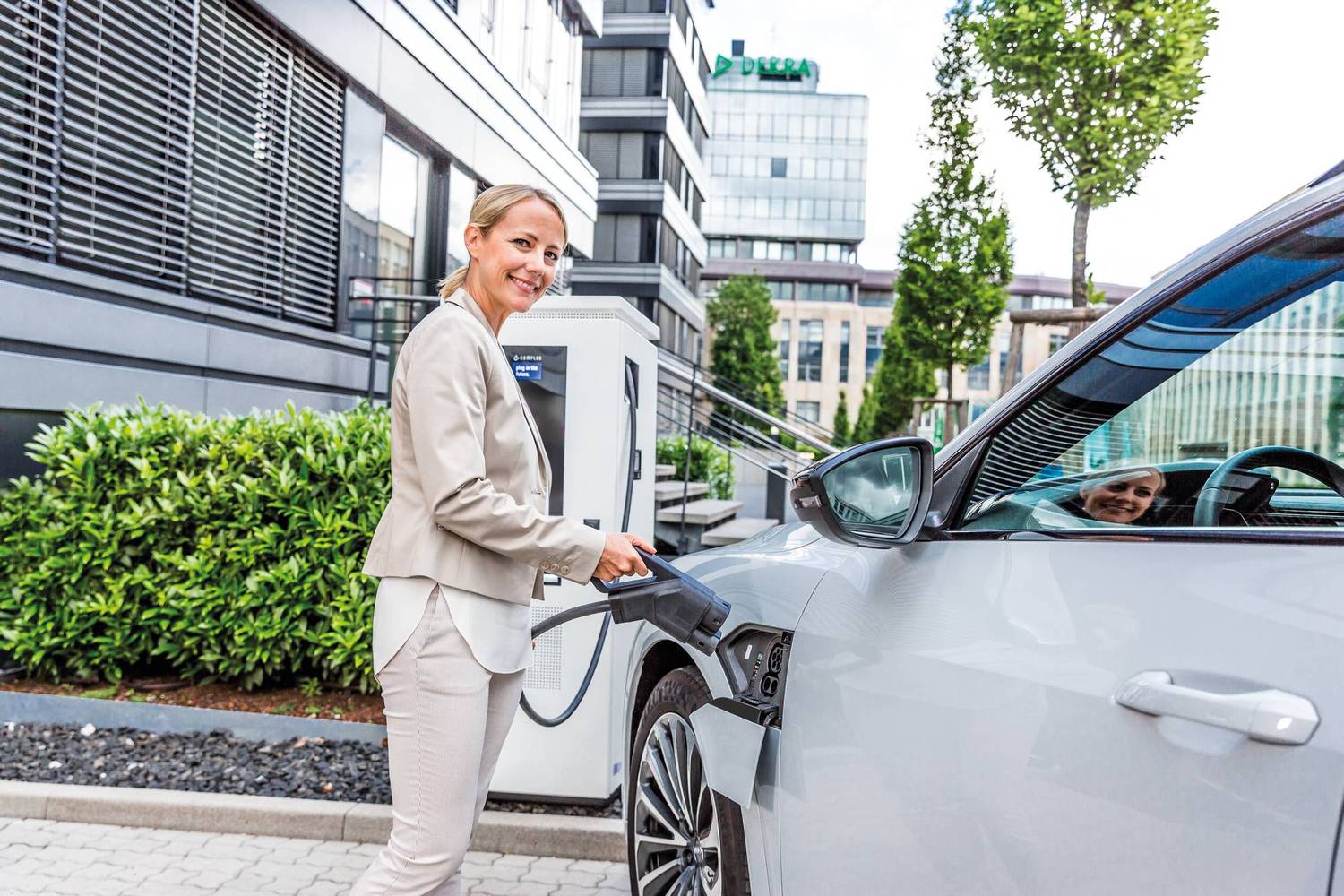Electric Car: Mission with Good Prospects
Author: Joachim Geiger
An electric car is essentially just another car on four wheels. Yet it’s likely to replace the internal combustion engine in the long run. To what technologies do electric cars owe their success? And does the electric car truly have ecological potential? We take a look under the e-car hood in a short series. Follow us!
The future probably belongs to the battery electric car. After all, the EU’s CO2 limit value policy places enormous demands on the efficiency of new vehicles. Things are getting tight for cars with combustion engines. Electric cars, on the other hand, are on a promising mission. They’re supposed to initiate the energy turnaround in transportation, relieve the environment of harmful emissions, and ensure individual mobility in society. So will it soon be “goodbye combustion vehicle, hello electric car”? Indeed, automotive brands already have their sights set on saying goodbye to classic drive technology. Volvo, for example, wants to become a pure electric car manufacturer by 2030, while US manufacturer GM plans to offer only zero-emission passenger cars from 2035. BMW, Daimler, and VW are also in the race – the Wolfsburg-based company, for example, wants to achieve more than 40 percent of total sales in Europe with electric cars by 2030.
- Good to know: What is an electric car anyway? The Electromobility Act (EmoG) recognizes three types of electrically powered vehicles. The pure Battery Electric Vehicle (BEV) has a drive that processes battery-provided energy exclusively by means of an electric motor. The battery is charged from the power grid via a socket or charging station. In accordance with the law, another electric player is the Plug-in Hybrid Electric Vehicle (PHEV). Technically, it’s defined as a system that has at least two different types of energy converters, one of which is an electric drive machine. In practice, a conventional combustion engine and an electric motor work as a team to provide propulsion. As with the BEV, charging takes place via the power grid. The third member of the group is the fuel cell vehicle. Here, the legislator defines a drive system whose energy converters consist exclusively of fuel cells and an electric drive machine.
Will it soon be “goodbye combustion vehicle, hello electric car?”
The question of whether customers will follow the manufacturers down this path is another matter. Germans have mixed feelings about all-electric drives, as the new DAT Report 2021 shows. According to the report, the main complaints are low range, long charging times, lack of infrastructure, and high purchase prices. On the other hand, a lack of knowledge about battery electric vehicles is often involved when buying a car. Electric cars, that much is certain, force users to say goodbye to the habits of using a conventional car. For DEKRA Solutions, this is a reason to take a closer look under the hood of pure electric cars in a small series.
- Good to know: Electromobility is picking up speed. In its market report on new passenger car registrations for 2020, the German Federal Motor Transport Authority (KBA) reports a share of 13.5 percent for vehicles with electric drive systems. At 29.9 percent, small cars are by far the strongest segment in terms of new registrations. They’re followed by SUVs (19.9 percent) and the compact class (19.6 percent). The number of pure electric vehicles (BEVs) increased over the course of the year from 136,617 units (at the beginning of 2020) to 309,083 units (as of January 1, 2021); for plug-in hybrids, numbers grew from 102,175 to 279,861. The balance for passenger cars with fuel cell-hydrogen drive is rather slim – here, the KBA records an increase from 507 to 808. This brings the various types of e-cars to a total of 589,752 units, which corresponds to a share of 1.2 percent of the total vehicle fleet in Germany.
A battery electric car is also just a car
Like a combustion vehicle, a pure electric car is ultimately just another car with four wheels. What’s the truth of this claim? Just hop in and take off? No problem with the e-car. Just plug in at the charging station? That will probably take longer. Calculating consumption with a calculator – liters times a hundred divided by kilometers? The calculation is on the right track – yet not quite correct in the end. Electric cars can’t be stalled when moving off because there’s neither a clutch nor a conventional transmission. There are no spark plugs, no starter, no exhaust, and no exhaust gas purification. At the gas station, there’s no need to search for the right engine oil because the electric motor doesn’t require lubrication. The fact that an electric car has fewer wear parts than a combustion engine is reflected in the cost of maintenance and inspection in euros and cents – in future, an inspection will probably be around 30 percent cheaper than for a combustion engine. However, the laws of driving physics apply equally to electric cars and combustion vehicles – with both, you can skid off the road if you take a turn too fast.
Electric cars are no buzzkill
The peculiarities of an electric car are best experienced by means of a test drive! Feel like putting pedal to the metal to hear the sound of the engine? Electric cars are remarkably quiet – the interior is silent until the tire noise becomes noticeable at higher speeds. On the other hand, they deliver plenty of torque and powerful acceleration right from a standstill – even a small electric car can easily outperform an ambitious combustion vehicle during a traffic light start. Recuperation is likely to be a new experience for many. “Manufacturers design their electric cars in such a way that they decelerate to a greater or lesser extent when the driver takes his foot off the accelerator,” knows Andreas Richter from the DEKRA Competence Center Electromobility. According to the engineer, the kinetic energy is then converted into electrical energy by the generator integrated into the drive and stored in the battery. “Depending on its strength, recuperation can increase the range by up to ten percent,” Richter explains. A tangible advantage is that wear and tear on the brakes takes place much more slowly than with a combustion vehicle. Recuperation also kicks in when the driver slows the vehicle with the service brake.
- Good to know: People who drive an electric car don’t want to go back. According to a user study by Düsseldorf-based research institute Innofact, environmental protection and sustainability are the main reasons for purchasing an all-electric vehicle. After the initial experience with the drive, however, another factor is added: driving pleasure. If they were to buy another car within the next 24 months, 85 percent of e-car drivers would again opt for a purely electrically powered car, while six percent would choose a plug-in hybrid. Five percent plan to buy a hydrogen-powered electric car, and only three percent can imagine returning to a combustion engine.
Are electric cars the cure-all of the energy revolution?
How sustainable are electric cars in truth? In recent years, experts have often been at odds over the methods, influencing factors, and data basis for this question. E-cars aren’t necessarily the saviors of climate-friendly mobility. “Of course, a locally emission-free e-car initially has a squeaky clean record – no carbon dioxide, no particulate matter, and no nitrogen oxides,” explains Peter Paul Ruschin, Head of the Sustainability Department at DEKRA. As the expert explains, the limitation lies in the word “local” – the vehicles are only emission-free where they’re being driven. If you unzip their ecological backpack, you’ll find a numer of “dirtier” secrets in it that come about in the various phases of the car’s life. CO2 emissions and the consumption of raw materials such as lithium, cobalt, and platinum in the construction of electric motors and batteries have a negative impact on the vehicle’s eco-credentials, for example. The disposal of batteries also ends up in the negatives column sooner or later. However, there are already recycling companies in Germany that recover more than 90 percent of the recyclable materials from discarded batteries.


“Ultimately, another critical position is the CO2 emissions generated at the electricity charging station,” reports Peter Paul Ruschin. It’s true that green electricity can be refueled at the home wallbox or public charging station – here as well as there, many electricity providers use eco-certificates to ensure that the energy comes from renewable production. However, there’s no dedicated grid for green electricity. What flows via the charging cable from the power grid into the battery of the electric car is, therefore, a mix of green electricity and electricity from non-renewable energy sources. The higher the proportion of clean electricity, the better it is for the eco-balance of the electric car.
- Good to know: More renewable energies in the current electricity mix. According to the Fraunhofer Institute for Solar Energy Systems ISE, the share of renewable energies in net electricity generation in Germany was 50.5 percent in 2020. The share of fossil fuels, hard coal, lignite, and gas, was 36.2 percent.
Of course, the electric car scores major points for its locally emission-free operation. Every kilometer driven by an electric car pays into the plus account. In current scientific studies and comparative tests by renowned media, electric cars are now almost always a nose ahead of combustion engines – from both an ecological and an economic perspective. The factors that play a role include falling purchase prices, higher unit sales, more efficient production methods, environmental bonuses, and tax exemptions until the end of 2030.
- Good to know: Electric car has a climate advantage over combustion vehicle. In a study on the climate footprint of electric cars presented in 2019, think tank Agora Verkehrswende came to the conclusion that drive energy is the most important factor influencing the climate footprint. The electric car has a climate advantage over the entire life cycle compared to the combustion vehicle, which will increase further if the expansion of renewable energies is accelerated. The think tank also expects that advances in battery development such as higher energy density, improved cell chemistry, and lower CO2 electricity during production will at least cut the battery’s ecological backpack in half.
With the electric car, range counts first – and second
Presumably, no one would think of discussing the size of the fuel tank for any length of time in a fuel chat among fans of the classic combustion car. In the case of the electric car, on the other hand, such a conversation is likely to be exciting – even though it has to revolve around the installed battery’s capacity. “The fear of running out of range still haunts many people. Admittedly, most people in this country barely drive more than 40 kilometers a day over the course of a year – so a significantly higher range would not actually be necessary,” reports DEKRA expert Andreas Richter. However, a skeptic would hardly be convinced by this argument. The manufacturers have understood this – the electric car only has a chance if it’s on par with the combustion engine. “Range is a key parameter for judging an e-car,” says Richter. In his view, the formula for this could be “large battery equals large range.” Most car brands provide electric car buyers with several battery sizes to choose from. Since the battery in the electric car is one of the most expensive components, the desire for greater range quickly cost a pretty penny.
A look at relevant market overviews shows that ranges of more than 300 kilometers are the norm for most manufacturers. Even distances of over 400 kilometers can be covered in one go with some series models. E-cars primarily designed as city vehicles usually have a range of around 200 kilometers. On the other hand, the range of an electric car isn’t set in stone, but depends heavily on ambient conditions. For example, it can be shorter or longer in cold or warm weather. Of course, individual driving behavior also plays a major role.
- Good to know: Tesla and Daimler are range champions. The benchmark in terms of range has so far been set by US manufacturer Tesla. Most of the Californian carmaker’s models exceed the magic mark of 500 kilometers and all Model S variants even go well over 600 kilometers. With the Mercedes EQS luxury sedan, Daimler has now launched a technology carrier with an electric range of up to 770 kilometers according to WLTP.
Patience is needed at the charging station
The infrastructure for charging electric cars is growing rapidly. Charging parks and stations are springing up in many places, offering a wide variety of charging options. In addition, more and more supermarkets, retailers, and service providers are making charging facilities available to their customers for the duration of their stay on site. Does that mean there’s a good chance that you can plug your car into a charging station and get enough power for the next leg of your journey? There’s usually little that can be done fast at the charging station. At a public charging station for AC charging, the car may have to stand for an hour or more for the battery charge level to increase significantly. In a charging park, DC charging at a high-power charging station is much faster, with a charging capacity of 150 to 350 kilowatts. However, this value only provides a rough estimate. How long it actually takes to fill up at the charging station depends on whether the vehicle can handle the charging power provided. Most electric cars charge at a significantly lower speed.
A convenient solution for energy replenishment is the private wallbox in carport or garage. Charging overnight is usually sufficient for the car to be fully charged the next morning. On the other hand, this alternative is not available to all households. Many electric car owners have to make do with other charging options. Refueling at electric charging stations or the nearest charging point often has to be learned before it becomes second nature. As they say, electric cars force us to rethink and learn.
- Good to know: The charging infrastructure is growing. The German Federal Network Agency currently lists around 36,000 standard charging points and 6,000 fast charging points. The German government has now introduced a fast charging law for nationwide fast charging infrastructure of pure battery electric vehicles, which stipulates the construction of 1,000 fast charging hubs by 2023. This should make fast charging at over 150 kilowatts possible.
Interview: Three questions for Andreas Richter, Engineer at the DEKRA Competence Center Electromobility
What advantages does an electric motor offer over a combustion engine?
Richter: The electric motor converts electrical energy into drive power with enormous efficiency exceeding 90 percent. Most of the energy is therefore used for driving. The balance of the combustion engine is much worse – in the city, the efficiency can be well below ten percent, at best it’s in the range of 25 to 40 percent. The rest of the energy is lost as unused heat.
How much power does an electric car need?
Richter: If the e-car is used purely as a city vehicle, even a nominally weak engine can keep up in city traffic because the maximum available torque is available to almost its full extent when accelerating from a standstill. However, the forward momentum of a smaller engine sooner or later runs out of juice on country roads or highways. If you want a dynamic sprint when overtaking or value the highest possible speeds, you need more power.
Which battery is the better choice – large or small?
Richter: A smaller battery scores points in its life cycle assessment with savings in raw materials, weight, and consumption. However, a smaller storage capacity means less range. If you value flexibility and long-distance capability, you’ll hardly be able to avoid a larger drive battery. Large batteries score points at electric charging stations with high charging capacities, which saves a lot of idle time. And because a large battery needs to be charged less often than a smaller model with the same mileage, its service life is also extended.

